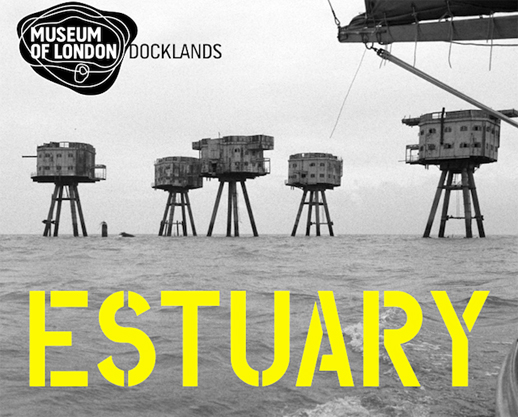Ken Worpole visits the Estuary exhibition which opened last week at the Museum of London Docklands:
This is a terrific exhibition: a must for all who love the Thames. Not surprisingly, for a museum based in the capital’s former docklands, the focus of the permanent collection – as well as this bold excursion into the contemporary arts – is the river east of Tower Bridge, recording the remnants of the industrial and imperial history of the Thames as it winds and widens out to join the sea. There’s a real feel for the wind and the waves, and the smack of saltwater in nearly every contribution. Its success may encourage the transformation of the Docklands Museum into a major new public gallery for contemporary work about this great historical mind-altering space. Let’s hope so.
No expense has been spared promoting ‘Estuary’. The opening night was jam-packed with people and awash with beer, champagne and oysters. Happily the exhibition remained the star: the crowds appeared galvanised by the vitality of the work and the way it had been curated and presented. Two large panoramic canvases by Jock McFadyen, of the river at Purfleet and at Dagenham, are hung to perfection – his work has never been exhibited so strongly. They hang beside canvases – one large and one small – by Michael Andrews, a major artist who died before his time and whose work is still too little known: both paintings are suffused with the browns, greys and greens of the estuary. Close by are two series of photographs of the Thames shoreline, one by Peter Marshall and the other by Gayle Chong Kwan, animated by enigmatic detail. A large photograph of Southend Pier by Simon Roberts mysteriously seems to detach the historic pier from its funfair hinterland, part of a long term project by the photographer to document Britain’s historic piers using a traditional 4” X 5” plate camera.
If you intend to visit – and you would miss something quite moving and profound if you don’t – allow plenty of time. At least half of the contributions are in the form of film, slide-show or digital installation. The longest of these, Portrait of a River (2013) by Nikolaj Bendix Slyum Larsen, at just under an hour long, is worth watching from start to finish: a lovely piece of beautifully structured social documentary. John Smith’s digital film installation Horizon (Five Pounds a Belgian) (2012), a wall-to-wall screening with haunting tidal roars and retreats, portrays views of the sea close to Margate, and is equally mesmerising. And there are at least three other film/slide installations to keep you occupied for another hour and a half at least. So give over an afternoon for a visit.
Too often when confronted with challenging landscapes, contemporary artists resort to trickery or kitsch. Fortunately, there seems to be something about the Thames as a working river which demands respect and honesty. There isn’t a trivial or pretentious piece to be found in ‘Estuary’, a muscular and eloquent triumph of commissioning and curating which subtly challenges the values of the surrounding corporate skyline. In the 1970s people turned their backs on the rivers and canals of Britain as somehow belonging to a grim, redundant past. The revival of interest in shoreline life and aesthetics is growing fast, and this exhibition consolidates a welcome return to the sea.
